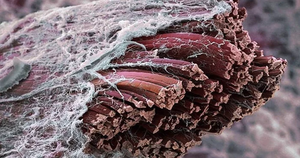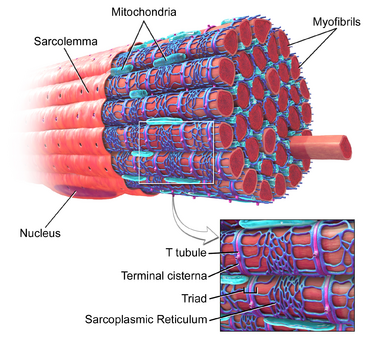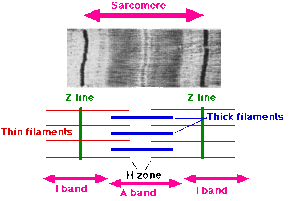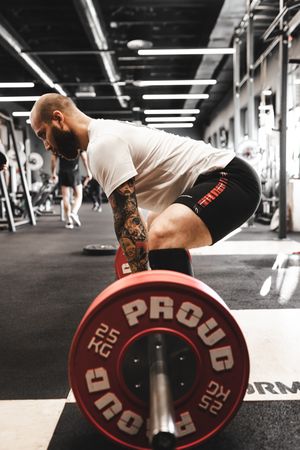Muscle Proteins
Original Editor - lucinda hampton
Top Contributors - Lucinda hampton
Introduction[edit | edit source]
Proteins are the basic material of tissue structure. They are the most important component of striated skeletal muscle.
Image 1: Fascia surrounding muscle fibres
The total amount of muscle proteins in humans exceeds that of any other protein. About 40 percent of the body weight of a healthy human adult weighing about 70 kilograms (150 pounds) is muscle, which is composed of about 20 percent muscle protein. Thus, the human body contains about 5 to 6 kilograms (11 to 13 pounds) of muscle protein[1].
Classification[edit | edit source]
The muscle proteins can be divided in to myofibrillar, regulatory, sarcoplasmic and stromal proteins
- Myofibrillar Proteins: Muscle fibers are composed of myofibrils. The proteins that comprise the myofibril, including actin and myosin and several more. The myofibrillar protein components most important for muscle fiber structure are actin and myosin. They are the most abundant proteins in muscle and are directly involved in the ability of muscle to contract and to relax[2]. Myosin constitutes as much as 35% of the total protein volume of skeletal muscles whilst actin is the most abundant protein in most eukaryotic cells.[3].
- Regulatory proteins: Include troponin, tropomyosin, M-protein, beta-actin, gamma-actin and C-protein. The are all important eg troponin-tropomyosin is responsible, in part, not only for transducing (ie converting to an electrical form) the effect of calcium on contractile protein activation, and also for inhibiting actin and myosin interaction when calcium is absent.[4]
- Image 3: Sarcomere.The sarcoplasmic proteins include hemoglobin and myoglobin pigments and a wide variety of enzymes. eg myogen, myoalbumin and x-globulin. Pigments from hemoglobin and myoglobin help to contribute the red color to muscle. Hemoglobin carries oxygen from the lungs to the tissues— including muscle. Myoglobin is present in muscle and it stores the oxygen transported to the muscle via the blood by hemoglobin until it is utilized in metabolism[2]. It has a dominant effect together with the mitochondria on the aerobic potential of muscles.[5]
- Stromal Proteins: Connective tissue is composed of a watery substance into which is dispersed in a matrix of stromal- protein fibrils. These stromal proteins are collagen, elastin (a key protein of the extracellular matrix) and reticulin (protein substance similar to collagen)[2].
- The remaining of proteins includes myofibrillar proteins of the Z-disc as well as small quantities of other proteins[5].
Muscle Protein Synthesis[edit | edit source]
Muscle protein synthesis (MPS) is the driving force behind adaptive responses to exercise and represents a widely adopted proxy for gauging chronic efficacy of acute interventions, (i.e. exercise/nutrition).
- In healthy, recreationally active individuals, skeletal muscle proteins display turnover rates of ∼1.2% day-1 and exist in dynamic equilibrium
- Muscle protein breakdown (MPB) exceeds muscle protein synthesis (MPS) in the fasted state, and MPS exceeds MPB in the fed state.[6]
- MPS can be enhanced by increasing your protein intake immediately following exercise. The amino acids derived from protein will then be shuttled to your muscles, replacing any lost to exercise. Learning how to stimulate MPS through exercise and diet can help accelerate muscle growth, improve recovery and athletic performance, and increase overall endurance.
Impact of Food
- The relationship between diet and protein balance is not straightforward. Even with increased protein intake, MPS is triggered for only a finite period of time. This is because the body can only utilize so much of the essential amino acids (EAAs) it receives; anything more will be broken down and excreted by the liver.
- To stimulate MPS, it is important to consume the appropriate amount of protein following exercise. Eating too much will not improve muscle growth but may increase the accumulation of potentially harmful byproducts such as urea[7].
See more: Muscle Function and Protein and Exercise and Protein
Physiotherapy[edit | edit source]
Educate clients about the importance of muscle mass.
It is recommend a two-phase approach to limit inactivity-mediated losses of muscle mass and function in older adults.
- Lifestyle: Educate re diet, they should eat a moderate amount (25-30 g) of high-quality protein with each meal and incorporate habitual exercise in close temporal proximity to protein-containing meals.
- Illness times eg hospital stay. To combat the accelerated loss of muscle mass and function during acute catabolic crises and periods of reduced physical activity educate clients that they should include nutritional support such as targeted protein or amino acid supplementation and integrated physical therapy.
References[edit | edit source]
- ↑ Britannica Muscle Proteins Available:https://www.britannica.com/science/protein/The-muscle-proteins (accessed 24.11.2021)
- ↑ 2.0 2.1 2.2 Belk, K., 2015. Does Muscle Tissue Contain Different Types of Protein. Champaign, IL: American Meat Science Association). Available:https://meatscience.org/TheMeatWeEat/topics/fresh-meat/article/2015/07/31/does-muscle-tissue-contain-different-types-of-protein (accessed 24.11.2021)
- ↑ Dominguez R, Holmes KC. Actin structure and function. Annual review of biophysics. 2011 Jun 9;40:169-86.Available: https://www.ncbi.nlm.nih.gov/pmc/articles/PMC3130349/ (accessed 24.11.2021)
- ↑ Malhotra A. Role of regulatory proteins (troponin-tropomyosin) in pathologic states. Molecular and cellular biochemistry. 1994 Jun;135(1):43-50.Available:https://pubmed.ncbi.nlm.nih.gov/7816055/ (accessed 24.11.2021)
- ↑ 5.0 5.1 Makovický P, Jílek F. Short review of some properties of muscular proteins. Ceskoslovenska fysiologie. 2008 Jan 1;57(1):10-4.Available:https://pubmed.ncbi.nlm.nih.gov/18630139/ (accessed 24.11.2021)
- ↑ Atherton PJ, Smith K. Muscle protein synthesis in response to nutrition and exercise. The Journal of physiology. 2012 Mar 1;590(5):1049-57.Available: https://www.ncbi.nlm.nih.gov/pmc/articles/PMC3381813/(accessed 24.11.2021)
- ↑ Vey well fit Is Muscle Protein Synthesis the Same as Growth? Available: https://www.verywellfit.com/muscle-protein-synthesis-and-muscle-growth-4148337(accessed 24.11.2021)










